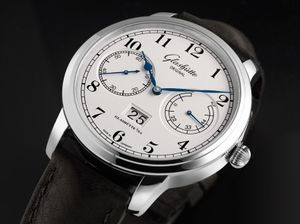Senator Observer 1911 – Julius Assmann/en: Unterschied zwischen den Versionen
| Zeile 1: | Zeile 1: | ||
'''Senator Observer 1911 – Julius Assmann''' | '''Senator Observer 1911 – Julius Assmann''' | ||
[[Datei:Senator Observer 1911 100-15-04-04-04 1.jpg|thumb|'''''The Senator Observer 1911 – Julius Assmann''''' limited to 25 pieces.]] | [[Datei:Senator Observer 1911 100-15-04-04-04 1.jpg|thumb|'''''The Senator Observer 1911 – Julius Assmann''''' limited to 25 pieces.]] | ||
| − | [[Datei:Assmann-Marine-Uhr.jpg|thumb|''''' | + | [[Datei:Assmann-Marine-Uhr.jpg|thumb|'''''Observation watch''''' <br>[[J. Assmann/Glashütte i.SA, Deutsche Anker-Uhren-Fabrik]]]] |
[[Datei:Senator Observer 1911 Glashuette Original 100-15-04-04-04 f.jpg|thumb|The dial presents subsidiary seconds and power reserve displays at 9 and 3 o’clock respectively; Glashütte Original’s characteristic panorama date display at 6 o’clock.]] | [[Datei:Senator Observer 1911 Glashuette Original 100-15-04-04-04 f.jpg|thumb|The dial presents subsidiary seconds and power reserve displays at 9 and 3 o’clock respectively; Glashütte Original’s characteristic panorama date display at 6 o’clock.]] | ||
December 19, 2011 | December 19, 2011 | ||
Version vom 22. Dezember 2011, 01:12 Uhr
Senator Observer 1911 – Julius Assmann
December 19, 2011
Honouring its rich heritage of more than 165 years of superior watchmaking in Glashütte, Germany, Glashütte Original is proud to present the Limited Edition Senator Observer 1911 - Julius Assmann.
This exceptional timepiece, handmade in the firm’s manufactory and limited to 25 pieces, pays homage to the pioneering spirit of two extraordinary men, Julius Assmann and Roald Amundsen.
Julius Assmann started his company at the age of 25 and is revered today as one of the founding fathers of watchmaking in Glashütte. Pocket watches, chronometers and observation watches crafted by Assmann and his employees were to play a significant role in establishing the company’s far-reaching reputation: the observation watches in particular were known for their remarkable precision and superior craftsmanship.
Before setting out on his historic voyage, Roald Amundsen acquired a number of Assmann observation watches, including one crafted by the young Glashütte watchmaker Paul Löwe in 1907/08. Löwe’s watch proved to be exceptionally precise, and he was urged to send it for testing to the German Naval Observatory in Hamburg, the institute officially responsible for testing and certifying the accuracy of navigational timekeepers made in Germany. It was there that Roald Amundsen saw the watch, and he purchased it in 1910.
On December 14th, 1911, the Norwegian polar explorer and his team became the first persons ever to reach the geographic South Pole.
Observation watches, also known as “deck watches” were used by navigation officers in conjunction with marine chronometers and other instruments to determine as precisely as possible a ship’s position at sea, and Amundsen will have made good use of his observation watches during his voyage to Antarctica on the polar ship, Fram.
Once he and his team set out from their base camp at Framheim on the Bay of Whales, however, the time kept by his observation watches became the only standard: one watch was set to a home time and assumed the function of the marine chronometer on a ship; a second watch was set to local time; measurement of the difference between the two was used to calculate, using spherical trigonometry, the team’s position during the trek to the South Pole; a compass and sextant were also used.
Thus, Amundsen’s observation watches were absolutely critical to his mission: without them, he could never have reached his destination, much less claimed victory for Norway. In Oslo today, the Fram Museum displays, along with many other artifacts documenting the historic trek, one of Amundsen’s Glashütte observation watches, complete with the inscription “J. Assmann – Glashütte” on the dial.
Glashütte Original Limited Edition Senator Observer 1911 - Julius Assmann
Observation watches continued to be manufactured in Glashütte until 1971, a testament to the ongoing production of high quality timepieces even during challenging times.
This splendid timepiece, presented in a limited edition of 25 pieces, bears the name “Senator Observer”, in honour of Julius Assmann’s observation watches and Amundsen’s achievement in reaching the South Pole. The Senator Observer 1911’s lacquered silver-grain dial is built up slowly from three separate layers of white lacquer, the third of which features a finely textured, silver-grain surface. The dial presents subsidiary seconds and power reserve displays at 9 and 3 o’clock respectively; Glashütte Original’s characteristic panorama date display at 6 o’clock; and blued and polished sweep minute and pear-shaped hour hands. A milled railroad chapter ring frames the black Arabic numerals.
The Senator Observer Limited Edition 1911 - Julius Assmann features a cylindrical case fashioned in white gold, complemented by a brown calfskin strap evocative of the age of pioneering adventurers and explorers epitomized by Amundsen.
The case back, engraved with the limited edition number (01/25), frames an antireflective sapphire crystal bearing the dates of Amundsen’s arrival at the South Pole and its centennial anniversary: 14 Dec. 1911 – 14 Dec 2011; the name Julius Assmann – Glashütte i/SA, and “Tribute to R. Amundsen”.


